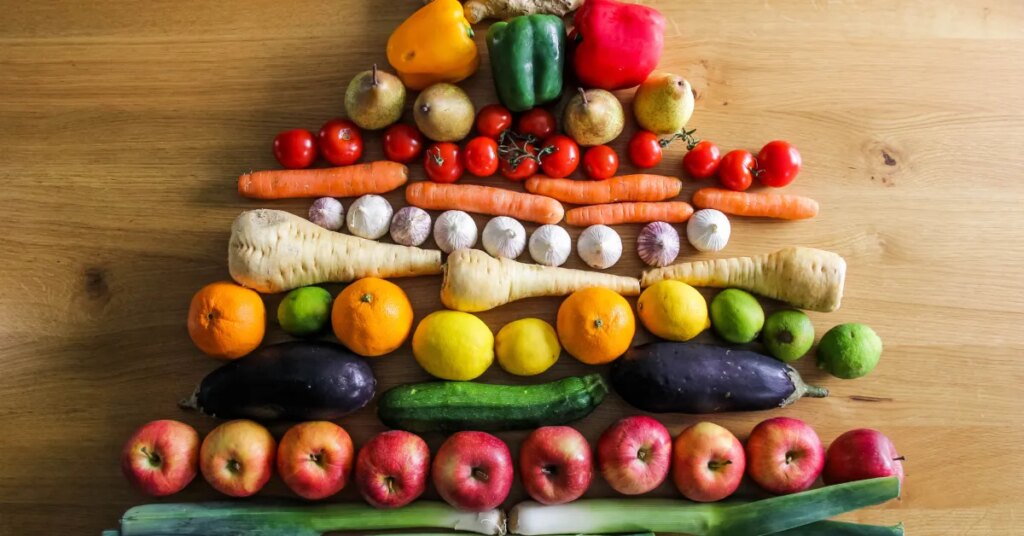Robert F. Kennedy Jr., President Donald Trump’s Health and Human Services (HHS) Secretary and man on a mission to “Make America Healthy Again,” has made no secret of his plan to change what he claims to be the country’s poison-riddled food culture. And he may soon bring back a relic from the past to help make that happen.
Bloomberg reported that the Trump Administration is considering reinstating the food pyramid when HHS and the U.S. Department of Agriculture (USDA) jointly update the U.S. Dietary Guidelines next month.
[time-brightcove not-tgx=”true”]
“We’re about to release dietary guidelines that are going to change the food culture in this country,” Kennedy told reporters earlier this month. HHS and USDA update the guidelines every five years.
An HHS spokesperson told Bloomberg Thursday that “Kennedy is committed to new dietary recommendations that are rooted in rigorous science” and that “the 2025–2030 Dietary Guidelines for Americans will be a big part of the Trump Administration’s commitment to Make America Healthy Again.” A USDA spokesperson said the updated guidelines “will address the chronic disease epidemic plaguing our nation, by prioritizing whole, healthy, and nutritious foods.”
TIME has reached out to both departments about the potential return of the food pyramid. Unnamed sources told Bloomberg that the visual is expected to focus on protein and whole foods, which Kennedy has long endorsed as he aims to steer the public away from ultra-processed food products.
Here’s what to know about the rise of the food pyramid as a guideline for the American diet, how it fell out of favor, and why it just may make a comeback.
The rise of the food pyramid
Nutrition advice from the USDA first came as a warning. Wilbur O. Atwater, a chemist and renowned nutritionist, published in an 1894 Farmer’s Bulletin: “Unless care is exercised in selecting food, a diet may result which is one-sided or badly balanced that is, one in which either protein or fuel ingredients (carbohydrate and fat) are provided in excess. … The evils of overeating may not be felt at once, but sooner or later they are sure to appear.”
Over the years, U.S. authorities have tried to make recommendations on what Americans should eat—and to create visuals so that the public can easily understand the dietary recommendations.
In 1943, during World War II, the USDA issued dietary advice in the form of the “Basic Seven,” which took into consideration potential shortages in food rations, according to a chapter by Carole Davis and Etta Saltos in the 1999 book America’s Eating Habits: Changes and Consequences. Three of the seven categories were dedicated to fruits and vegetables, and one slot each was dedicated to the following: milk and milk products; meat, poultry, fish, and eggs; bread, flour, and cereals; and butter or fortified margarine. But it didn’t recommend a portion size of each food group.
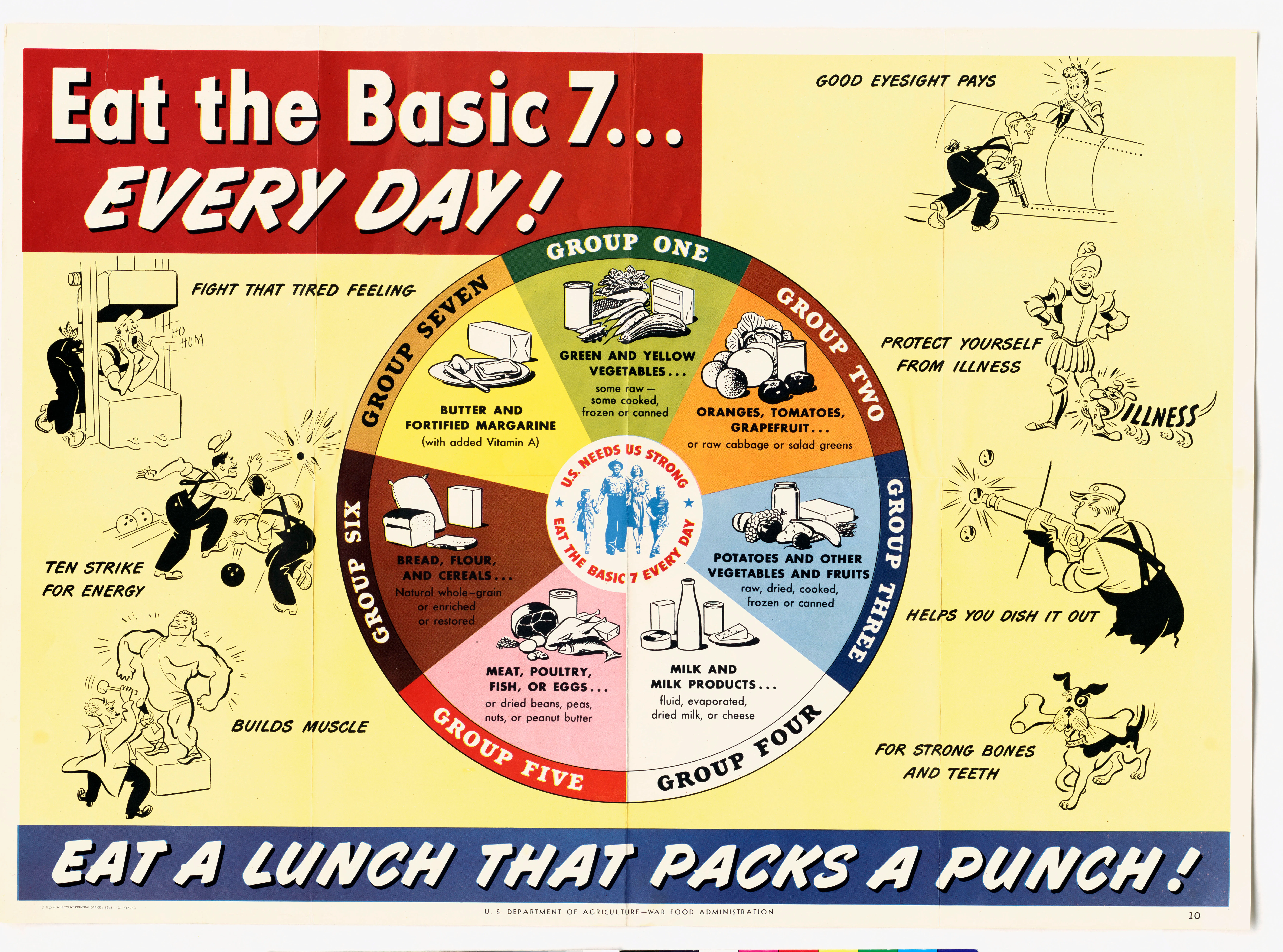
In 1956, the Basic Seven was simplified to the Basic Four, organized into the groups: milk, meat, vegetable-fruit, and bread-cereal. It also provided rough daily serving suggestions for each group: four servings each for vegetable-fruit and bread-cereal, two for meat, and “some” for milk and milk products.
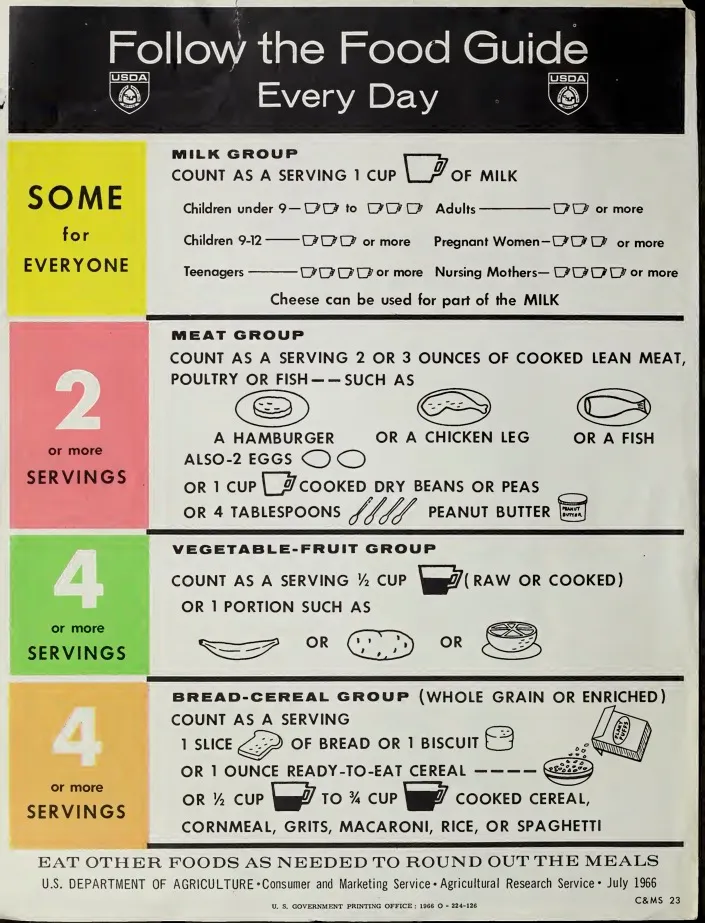
In the 1970s, the U.S. Dietary Guidelines as Americans know it today began to take shape, as disease became increasingly linked to unhealthy diets. Dietary fat was increasingly under scrutiny, and in 1977, a Senate committee led by Sen. George McGovern (D, S.D.) released Dietary Goals for the United States that recommended consuming less sugar, sodium, and fat—and more complex carbohydrates and “naturally occurring” sugars.
Then, in 1980, the USDA and the HHS released the seven-point Dietary Guidelines for Americans, as the overconsumption of sugar, fat, saturated fat, cholesterol, and sodium steadily gained recognition as risk factors for developing chronic diseases. To illustrate what a healthier diet would look like at the time, the USDA, in cooperation with the American National Red Cross, presented consumers with “The Food Wheel: A Pattern for Daily Food Choices” in 1984.

Four years later, the food guide was released in a pyramid format. The width of the pyramid level roughly indicated the proportion of food servings: at its base were bread, rice, cereal, and grains, which should have the largest servings; and at its apex were fats and sweets, which should be consumed sparingly.
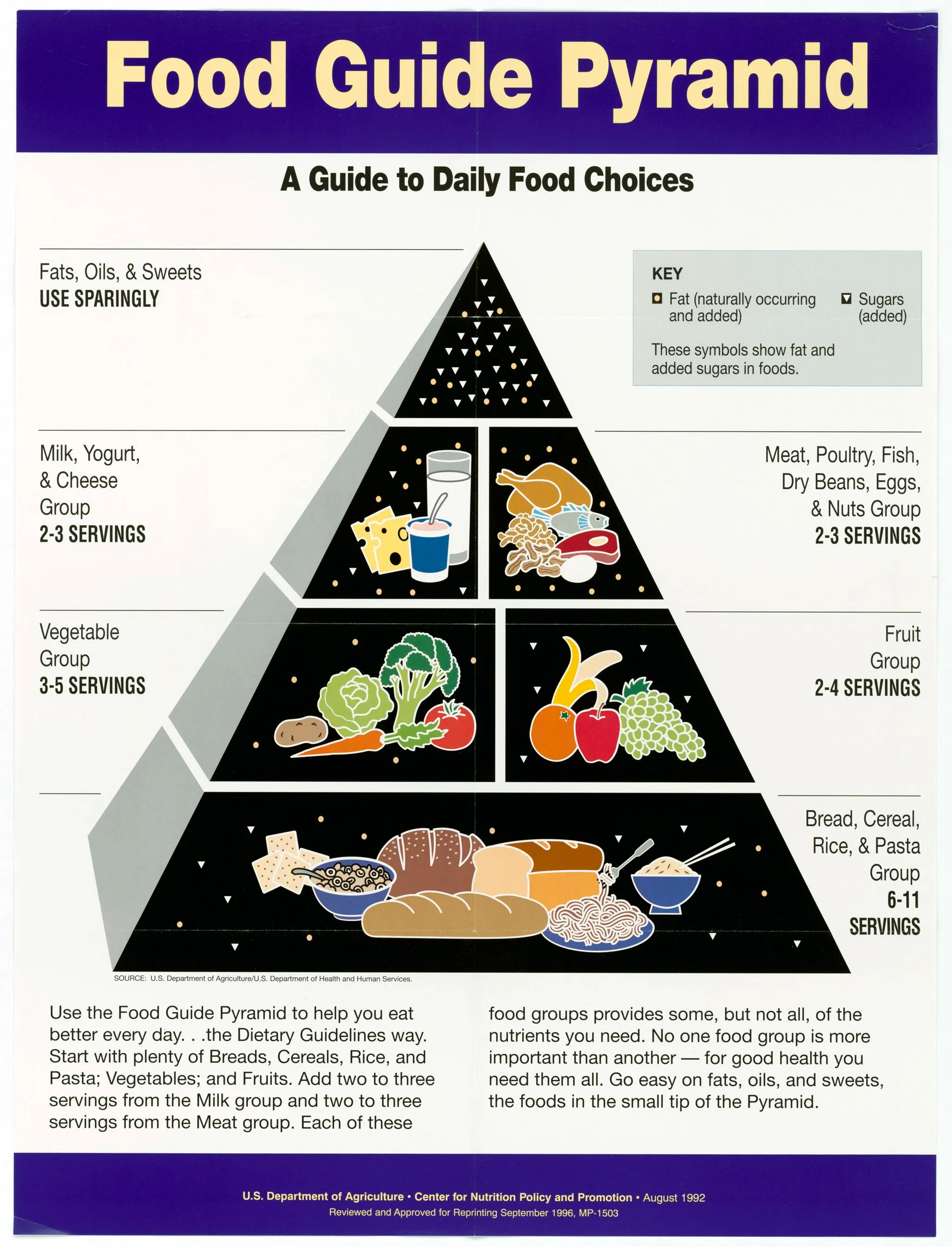
The fall of the food pyramid
But even the pyramid drew flak for still being broad and vague. For instance, it recommended that Americans eat 6 to 11 servings of grains, but details such as serving sizes and which specific food items within each category were healthier options (like brown rice compared to white rice) remained unclear. Critics also highlighted how it failed to account for individual differences in dietary requirements, such as across different age and health demographics.
To address those concerns, work began in 2003 to update the pyramid, and two years later, the a new version was released, called MyPyramid. It was outfitted with stairs, meant to remind Americans of the need for exercise, and its food divisions were flipped to the side, in bands of varying colors to represent different food groups: orange for grains, green for vegetables, red for fruits, yellow for oils, blue for milk, and purple for beans and meats.
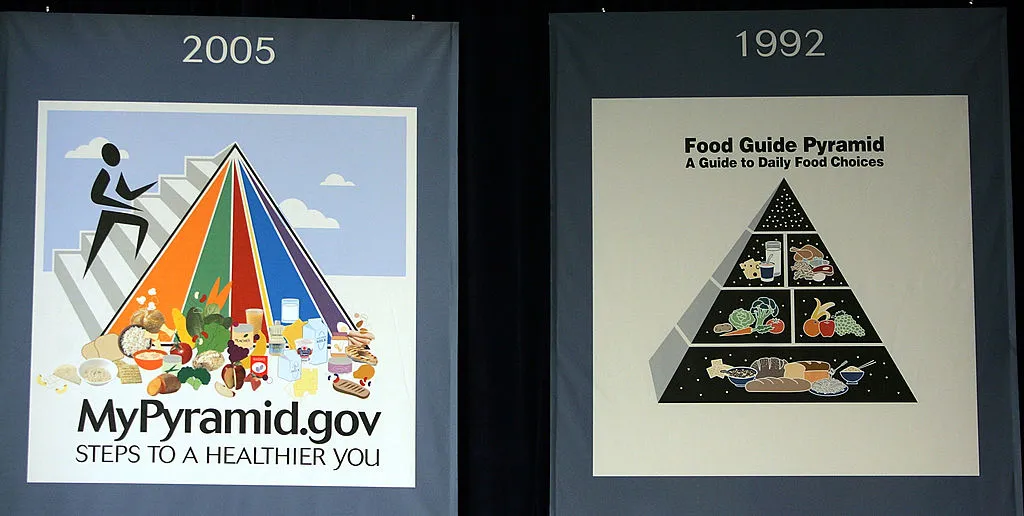
In 2011, the U.S. abandoned the food pyramid in favor of what it called MyPlate, which used a plate to represent what the average person should eat per the latest Dietary Guidelines for Americans. Tom Vilsack, then the Agriculture Secretary, described MyPlate as a “simple, visual, research-based icon that is a clear, unmistakable message about portion size.”
MyPlate’s recommendations are easy to follow: half of a plate should contain fruits and vegetables, and roughly a quarter each for grains and protein. A smaller plate to the side was for dairy. The goal, as then-First Lady Michelle Obama presented it, was to make the American plate look like the one shown in the MyPlate graphic.
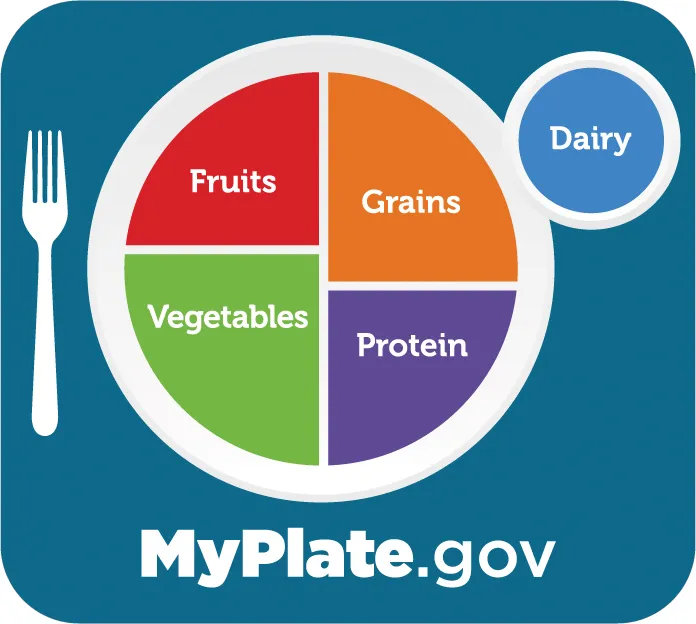
The potential return of the food pyramid
Details on what a new dietary guideline visual will look like are still under discussion, Bloomberg reports.
Kennedy, who as HHS Secretary oversees nutrition standards, has vocally advocated against ultraprocessed foods, which he claims are “poisoning” Americans, blaming such products for causing chronic diseases and high national obesity rates.
But Kennedy has also peddled misinformation about food. He’s spoken out against seed oils like canola and soybean, even though experts have touted their health benefits, and has endorsed beef tallow as a replacement. He has also embraced raw milk, even though food safety experts have warned of the high risk of contracting food-borne illnesses from consuming it.
The forthcoming guidelines have caused anxiety among nutritionists, given Kennedy’s beliefs. At a July event in Colorado, Kennedy said the guidelines will “stress the need to eat saturated fats,” which are associated with health risks. That same month, Kennedy also promoted full-fat dairy products, criticizing what he described as an “attack on whole milk, cheese, and yogurt” as he announced his overhaul of the nation’s dietary guidelines.

“The dietary guidelines that we inherited from the Biden Administration were 453 pages long,” Kennedy said in August, though the current guidelines are only 164 pages. “They were driven by the same commercial impulses that put Froot Loops at the top of the food pyramid.”
While the food pyramid may be brought back, albeit likely with different details, Kennedy has indicated that the new guidelines in total will be just a few pages long.
Kevin Klatt, a research scientist and instructor in the Department of Nutritional Sciences and Toxicology at University of California, Berkeley, says that such a reform reflects “a bit of a misunderstanding of the role of the Dietary Guidelines.”
“The title indicates they are ‘for Americans’ but the user is not actually intended to be the American public,” Klatt said in August. “Since 2005, the dietary guidelines have really been intended to be used by healthcare professionals and as a policy document. The current administration seems to want to roll that back, and doesn’t seem to acknowledge that it’s a policy document.”
The post The Rise, Fall, and Potential Return of the Food Pyramid appeared first on TIME.
